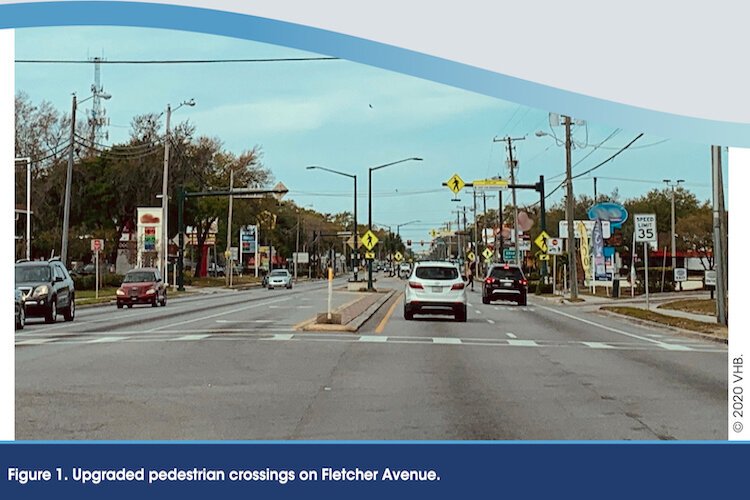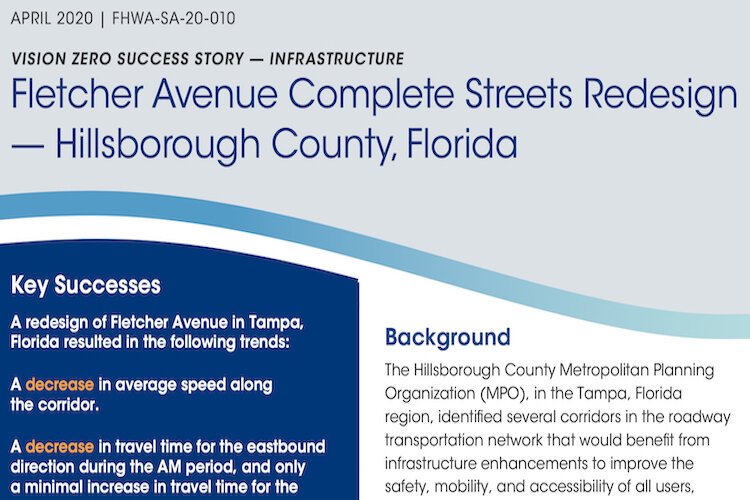Fletcher Avenue as a ‘Complete Street’ is now safer for pedestrians, cyclists
The redesign of Fletcher Avenue in north Tampa highlights the value of a “complete streets” philosophy of reimagining streets that work for people of all ages and abilities, whether they are pedestrians, cyclists, or motorists.
A redesign of Fletcher Avenue lays out a roadmap to a safer streetscape for motorists, pedestrians, and bicyclists in Hillsborough County and Tampa, according to a report from the Hillsborough County Metropolitan Planning Commission.
A prior study identified Fletcher Avenue, near the University of South Florida, as one of 20 “severe crash corridors” in the county. In 2011-2013, Fletcher from Nebraska Avenue to Bruce B. Downs Boulevard averaged more than 1,100 total daily pedestrian crossings.
The redesign highlights the value of a “complete streets” philosophy of reimagining streets that work for people of all ages and abilities, whether they are pedestrians, cyclists, or motorists.
With Fletcher as a guide, the MPO recommends annual “complete streets” projects that in about five years would redesign about 370 miles of roadway. Funds would come from the transportation surtax.
Street light enhancements and filling in sidewalk gaps would also be completed. The goal is to reduce injury and fatal crashes by 35 percent by 2045.
In the past motorists and their vehicles had priority in street design, with the goal of moving traffic as quickly and efficiently as possible. Pedestrians and bicyclists received scant attention.
“Fletcher Avenue was emblematic of the street design philosophy since World War II, which is that streets should be designed as if they were highways, with little consideration of the local context,” says Ken Sides, project manager and senior transportation engineer with Sam Schwartz Engineering.
The “local context” often meant pedestrians, for instance, would cross the street at the closest point to where they wanted to go, Sides says. “But the traffic profession has long pretended they don’t, preferring instead to imagine people would go considerably out of their way to cross at an intersection.”
Even at intersections, Sides says pedestrians confront hazards as they walk near cars coming at them from all directions.
The Fletcher redesign sought to address those issues.
In 2015, the Hillsborough County Public Works Department completed a redesign that upgraded pedestrian crossings, installed light-emitting diode (LED) lighting at the crossings, raised safety islands and traffic separators and striped new bicycle lanes on both sides of the roadway. In addition, the speed limit was reduced from 45 miles per hour to 35 mph.
The MPO study analyzed the behaviors of pedestrians, bicyclists, and motorists who traveled on Fletcher. They observed how people used crosswalks and whether they would use the crosswalks properly.
After the redesign, data showed more people using crosswalks, pushing walk buttons, and fewer bicyclists riding on sidewalks.
A review of crash data found 73 non-incapacitating injuries; 37 incapacitating injuries; and five fatalities over three years prior to the upgrades. During three years after the upgrades, data found 46 non-incapacitating injuries, or a 37 percent reduction; 20 incapacitating injuries, or a 46 percent reduction; and two fatalities, or a 60 percent reduction.
An expanded study that reviewed data four years before and after the project further supported the successes of the redesign. From 2010-2013, there were 93 fatal and serious injury crashes on an approximately 3 mile stretch of Fletcher; and, from 2015-2018, the number decreased to 38 fatal and serious injury crashes.
Making progress toward a safer roadway has taken many years and several studies, says Sides.
Angelo Rao, now an engineering consultant for Hillsborough County, participated in the initial study reviewing data from 2006-2008. Rao then served as a Hillsborough traffic engineer.
That study looked at three intersections along Fletcher from 46th Street to 56th Street. It also considered how pedestrians and motorists interacted and made safety recommendations.
“Fletcher Avenue is a case study in how to retrofit an urban highway design to recognize the obvious reality that people do walk across the street to get what they need,” said Sides.
The project cost about $4.7 million and included a $2.5 million grant from the Florida Department of Transportation.














